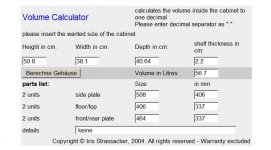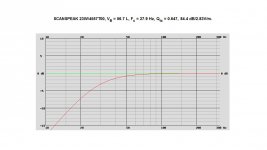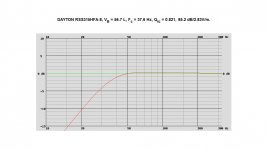Hi all,
I'm new to DIY, but reading about a lot of interesting DIY projects here on diyaudio made me wonder, if it will be possible to build 2x 12" subs that will perform much better (produce tighter and faster bass) than my single Velodyne Optimum 12".
Since the WAF is very important and I am limited in space 12" will be the max driver size.
Max. box size:
20" width
15" height
16" depth
So I guess sealed boxes are the way to go?
They will be used for 50%/50% Music/Home theater.
I know I will get much better performance with 15" or 18" drivers, but simply cannot find the space for such large boxes 🙁 (Nor the wifes acceptance 😉 )
I'm not looking for budget project drivers, performance really is the most important factor to me.
It would be a GREAT help if you DIY gurus could help me with suggestions to drivers that will outperform my Optimum - if possible at all ...
I really appreciate your help
Thank you
/Martin
I'm new to DIY, but reading about a lot of interesting DIY projects here on diyaudio made me wonder, if it will be possible to build 2x 12" subs that will perform much better (produce tighter and faster bass) than my single Velodyne Optimum 12".
Since the WAF is very important and I am limited in space 12" will be the max driver size.
Max. box size:
20" width
15" height
16" depth
So I guess sealed boxes are the way to go?
They will be used for 50%/50% Music/Home theater.
I know I will get much better performance with 15" or 18" drivers, but simply cannot find the space for such large boxes 🙁 (Nor the wifes acceptance 😉 )
I'm not looking for budget project drivers, performance really is the most important factor to me.
It would be a GREAT help if you DIY gurus could help me with suggestions to drivers that will outperform my Optimum - if possible at all ...
I really appreciate your help
Thank you
/Martin
What power amp do you have?
A sealed enclosure for one driver (each)?!😀
56.7L= 2.00ft³
Drivers advisable:
(With correction or not. Of course if freq. is of importance you can always use a LT.)
9" Scanspeak 23W/4557T00 Sub
and about 40/50W RMS (12.01 V) for @Xmax.
Scan-Speak
Scanspeak 23W/4557T00 SubWoofer - Revelator Range
https://www.madisoundspeakerstore.c...557t-02-9-aluminum-cone-subwoofer-black-cone/
12" Dayton Audio RSS315HFA-8 Reference
power amp for 260W/41.03 V @Xmax.
Dayton Audio RSS315HFA-8 12" Reference HF Subwoofer 8 Ohm daytonaudio
Dayton Audio RSS315HFA-8 12" Reference HF Subwoofer 8 Ohm parts-express
A sealed enclosure for one driver (each)?!😀
56.7L= 2.00ft³
Drivers advisable:
(With correction or not. Of course if freq. is of importance you can always use a LT.)
9" Scanspeak 23W/4557T00 Sub
and about 40/50W RMS (12.01 V) for @Xmax.
Scan-Speak
Scanspeak 23W/4557T00 SubWoofer - Revelator Range
https://www.madisoundspeakerstore.c...557t-02-9-aluminum-cone-subwoofer-black-cone/
12" Dayton Audio RSS315HFA-8 Reference
power amp for 260W/41.03 V @Xmax.
Dayton Audio RSS315HFA-8 12" Reference HF Subwoofer 8 Ohm daytonaudio
Dayton Audio RSS315HFA-8 12" Reference HF Subwoofer 8 Ohm parts-express
Attachments
Really think given the fact that you're looking for the best performance in a small package, you should go with these drivers.
TC Sounds LMS-R 12" DVC Subwoofer
They're very capable with a ton of available excursion and aren't insanely expensive. The low VAS means you can make very small boxes.
That said, you should specify some kind of budget, because taking your performance-at-any-cost idea to the extreme means playing with these is an option.
RE Audio XXX12-v2-4 12" Cast Frame DVC Subwoofer Driver 4+4 Ohm
Which would be cool, but also incredibly expensive.
TC Sounds LMS-R 12" DVC Subwoofer
They're very capable with a ton of available excursion and aren't insanely expensive. The low VAS means you can make very small boxes.
That said, you should specify some kind of budget, because taking your performance-at-any-cost idea to the extreme means playing with these is an option.
RE Audio XXX12-v2-4 12" Cast Frame DVC Subwoofer Driver 4+4 Ohm
Which would be cool, but also incredibly expensive.
Last edited:
Small space + big output requirements + generous budget = look at the Stereo Integrity HST-12 🙂
Generous output was not mentioned by OP, he did mention fast and tight bass though. Usually systems that have low box qtc and lots of upper bass are subjectively described as fast and tight. Also, OP's current sub has lots of built in processing power to auto eq room effects as well as other things.
The SI 12 drivers will give the opposite of subjectively fast and tight bass, in fact they will sound boomy and sloppy in room unless they have at least as much dsp processing power as OP's current sub.
Not sure if the box size mentioned by OP was for 1 or 2 drivers, but I simulated both situations. I assumed 60 liters internal space and subtracted 5 liters per driver for driver and bracing space, this probably isn't enough as the drivers are huge and lots of bracing should be used so my boxes probably should have been simulated even smaller.
Row 1 - Hornresp inputs
Row 2 - Frequency response (blue is normal sim, red is inductance corrected, due to the very high inductance the red trace WILL be more accurate than the blue normal sim trace)
Row 3 - excursion (same thing with blue and red inductance corrected traces)
Left column - 2 drivers per box, 4000 watts input
Right column - 1 driver per box, 1100 watts input
(Reported qtc is for the blue trace, not the red trace. In both cases the red trace qtc is MUCH higher.)
So it's clear to see that a massive amount of power is going to be required to get these things to claimed xmax in a box (or 2 boxes) of this size. And due to the high box q (due to the inductance hump) and the very weak and rolled off high frequencies (due also to inductance), this driver is going to sound boomy as hell in room (the opposite of subjectively tight and fast) unless you have at least eq, and ideally a lot of dsp processing power.
I'm not saying the drivers are bad, but they are expensive and definitely not the right tool for the job when "tight and fast" are goals and spl output isn't even mentioned.
An externally hosted image should be here but it was not working when we last tested it.
Last edited:
Really think given the fact that you're looking for the best performance in a small package, you should go with these drivers.
TC Sounds LMS-R 12" DVC Subwoofer
They're very capable with a ton of available excursion and aren't insanely expensive. The low VAS means you can make very small boxes.
That said, you should specify some kind of budget, because taking your performance-at-any-cost idea to the extreme means playing with these is an option.
RE Audio XXX12-v2-4 12" Cast Frame DVC Subwoofer Driver 4+4 Ohm
Which would be cool, but also incredibly expensive.
Both of these drivers are going to have the same inductance issues as the SI driver I just simulated. Without seeing measurements of these exact drivers or doing sims, but having seen the data-bass measurements of their respective 18 inch big brothers, the TC driver will probably be a bit less affected than the SI and the RE XXX will be a huge inductance mess with a massive inductance hump (which also means a very high sealed box qtc) and a severely rolled off top end.
Again, the opposite of subjectively fast and tight.
More "normal" drivers like the ones suggested by Inductor are the way to go for subjectively "fast and tight", although even the Dayton RSS is going to have a small amount of inductance issues (based purely on the data-bass measurement is it's 18 inch big brother).
Most of the drivers mentioned so far have unusually high claimed xmax, this comes at the cost of inductance issues. Take a look around data-bass sealed box measurements for this type of driver and you will find that inductance humps and rolled off top end are par for the course, and this is not "fast and tight" sounding unless you can do a significant amount of frequency response processing.
True enough, but with this sort of budget for drivers, I'd expect a Behringer DSP amp to be on the cards. That'll be most of the processing required, though a measurement setup would be useful, too.
I'd quite like to play with that RE audio driver as part of a PA system. Smallish box, couple of PRs tuned to 35Hz, and it'd probably keep up with a double-18" cab at the bottom end. I bet efficiency goes through the floor towards 100Hz, though.
Chris
I'd quite like to play with that RE audio driver as part of a PA system. Smallish box, couple of PRs tuned to 35Hz, and it'd probably keep up with a double-18" cab at the bottom end. I bet efficiency goes through the floor towards 100Hz, though.
Chris
WOW - thanks a lot guys for some really great feedback!
I must admit though I don't have enough knowledge yet when it gets too technical because I'm all new to DIY projects.
I'm still trying to learn by reading lots of posts, but It will be your suggestions of the best price/performance driver I will choose.
Just to clarify I would like to build 2 seperate subs with 1 driver each.
I haven't decided on a precise budget yet, but was hoping that $300-$400 per driver could do the job.
I was planning to use 1x Behringer Inuke 3000 DSP to power both subs.
According to P.E. the Dayton Audio RSS315HFA-8 12" Reference HF mentioned by Inductor seems to be optimized for larger enclosures and these seems to be fit for smaller enclosures:
Dayton Audio RSS315HO-44 12" Reference HO DVC
Dayton Audio RSS315HO-44 12" Reference HO DVC Subwoofer
Dayton Audio RSS315HO-4 12" Reference HO Subwoofer 4 Ohm
Dayton Audio RSS315HO-4 12" Reference HO Subwoofer 4 Ohm
Dayton Audio UM12-22 12" Ultimax DVC
Dayton Audio UM12-22 12" Ultimax DVC Subwoofer 2 ohms Per Coil
So wouldn't one of the others DA drivers be a better choice than the DA RSS315HFA-8 12" Reference HF?
If of any importance yet this is the rest of my setup so far:
Reciever: Anthem MRX-710
Fronts: MK Sound LCR-950
Back: MK Sound Surr55 to be replaced with Surr95 asap.
Again I just cannot thank you all enough for spending your precious time helping me - THANKS !!
(btw I hope my english is good enough as I'm from Denmark 🙄 )
I must admit though I don't have enough knowledge yet when it gets too technical because I'm all new to DIY projects.
I'm still trying to learn by reading lots of posts, but It will be your suggestions of the best price/performance driver I will choose.
Just to clarify I would like to build 2 seperate subs with 1 driver each.
I haven't decided on a precise budget yet, but was hoping that $300-$400 per driver could do the job.
I was planning to use 1x Behringer Inuke 3000 DSP to power both subs.
According to P.E. the Dayton Audio RSS315HFA-8 12" Reference HF mentioned by Inductor seems to be optimized for larger enclosures and these seems to be fit for smaller enclosures:
Dayton Audio RSS315HO-44 12" Reference HO DVC
Dayton Audio RSS315HO-44 12" Reference HO DVC Subwoofer
Dayton Audio RSS315HO-4 12" Reference HO Subwoofer 4 Ohm
Dayton Audio RSS315HO-4 12" Reference HO Subwoofer 4 Ohm
Dayton Audio UM12-22 12" Ultimax DVC
Dayton Audio UM12-22 12" Ultimax DVC Subwoofer 2 ohms Per Coil
So wouldn't one of the others DA drivers be a better choice than the DA RSS315HFA-8 12" Reference HF?
If of any importance yet this is the rest of my setup so far:
Reciever: Anthem MRX-710
Fronts: MK Sound LCR-950
Back: MK Sound Surr55 to be replaced with Surr95 asap.
Again I just cannot thank you all enough for spending your precious time helping me - THANKS !!
(btw I hope my english is good enough as I'm from Denmark 🙄 )
None of the really high excursion subs will work very well in very small boxes. The sim I did above (the one with 1 driver per box) is shown at 1100 watts. So for 2 boxes you have 2200 watts. I'm not sure the Behringer 3000 can do that for sustained notes, and even if it can that will cause significant power compression in the drivers.
So bigger boxes would be better, unless you choose drivers that don't try so hard to have extreme excursion capability. This will also have advantages in inductance and native frequency response.
Also note that subs can be hidden in furniture, this may allow larger box sizes.
And you can boost top end response naturally with stuff like PPSL slots if they are designed properly and if you need the boost due to inductance issues and power handling capability, but that takes extra box volume and if you want the PP part both drivers have to be in the same box, so it would be more than double your requested single box volume.
When you say "best price/performance driver" you really have to define "performance" with target goals. To most people performance with be peak spl but if you are more worried about things like "fast and tight" you will get very different answers on which way to go.
I strongly recommend using a simulator to evaluate your top choices. It won't tell you how anything sounds but it will show you how close it comes on certain metrics if you can intelligently interpret the data it shows in the larger context.
So bigger boxes would be better, unless you choose drivers that don't try so hard to have extreme excursion capability. This will also have advantages in inductance and native frequency response.
Also note that subs can be hidden in furniture, this may allow larger box sizes.
And you can boost top end response naturally with stuff like PPSL slots if they are designed properly and if you need the boost due to inductance issues and power handling capability, but that takes extra box volume and if you want the PP part both drivers have to be in the same box, so it would be more than double your requested single box volume.
When you say "best price/performance driver" you really have to define "performance" with target goals. To most people performance with be peak spl but if you are more worried about things like "fast and tight" you will get very different answers on which way to go.
I strongly recommend using a simulator to evaluate your top choices. It won't tell you how anything sounds but it will show you how close it comes on certain metrics if you can intelligently interpret the data it shows in the larger context.
I'd quite like to play with that RE audio driver as part of a PA system. Smallish box, couple of PRs tuned to 35Hz, and it'd probably keep up with a double-18" cab at the bottom end. I bet efficiency goes through the floor towards 100Hz, though.
Chris
Have you simulated it?
According to all the specs on both the RE and PE website they are dual 4 ohm drivers but Re is listed at 4.2 ohms (per coil) on the Re site and 4.2 ohms (total) on the PE site. Additionally, when entering these specs into Hornresp the only option that makes any sense with the stated Bl is 4.2 ohms total. Also, data-bass measured the 18 inch big brother at 4.2 ohms total, and the 12 and 18 have got the same motor and same claimed specs for Bl and Re.
To avoid any confusion I just simulated the 18 inch driver with data-bass measured specs, you can do your own sim with the 12 inch or just concede that the results will be similar.
Since things are going to look really weird I'll set the baseline by simulating the RE XXX 18 and comparing to data-bass's sealed box measurement. (This is the split coil version, the older version, which has specs more similar to the published specs.)
Graph 1 - data-bass measured results in 4.5 cu ft sealed box
Graph 2 - Hornresp inputs using data-bass measured t/s and box size
Graph 3 - normal (blue) and inductance corrected (red) sim frequency response
As you can see the red trace in the simulation is is a pretty good match to the measurement. It's a couple db low (all the inductance corrected sims are) but the peak is pretty close to the right spot and it's about 7 db down at 100 hz. The uncorrected blue trace sim is not even close.

Having set the baseline, let's put that RE XXX 18 into the manufacturer's recommend ported box size (9 cu ft + port size) tuned to 34 hz. I used a very short port so it wouldn't affect the frequency response with harmonic spikes (to represent the passive radiator you mentioned) and to keep the port from taking any box volume (to keep the box to the manufacturer's recommended size).
Again, red is inductance corrected, blue is regular sim.

For PA use this is a train wreck. The normal sim is bad enough, the predicted inductance corrected sim is even worse. This is how you win spl competitions but it's not how you run a PA.
This driver doesn't even begin to sim well in a ported box until you do what data-bass did with it, very low tuning in a huge box. They did 34 cu ft with 12 hz tuning, and even then it didn't measure very well in terms of a normal looking frequency response, it had a huge hump at 25 hz and massive rolloff on both sides of that hump.
I suspect the 12 inch version is going to give similar results. For best results use this in a large sealed box with primary system goal of hitting single digit frequencies at high spl. It's not really good for much else. With a high tuned ported box it would take a power plant to get it anywhere near it's claimed 54 mm xmax, and it doesn't have the power handling to take that, so it's just a waste of potential in that type of box.
Last edited:
PrepsDK,
I haven't listened to a Velodyne Optimum, but I trust it is very nice! A worthy candidate could well be 12" GR/Rythmic servo sub...here are several pics of one that I built. Fast and musical and I also use it 50/50 for HT and music. It doesn't shake the rafters in the home next door but it does shake the rafters in my home. 🙂
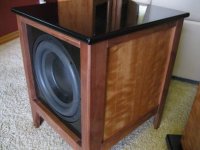
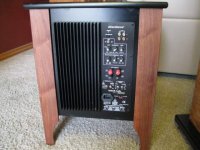
With the legs, the Dims are a bit larger than your requirements...
16.5" wide
22" Height
18" deep
If you build without legs, the dimensions meet your requirements.
I haven't listened to a Velodyne Optimum, but I trust it is very nice! A worthy candidate could well be 12" GR/Rythmic servo sub...here are several pics of one that I built. Fast and musical and I also use it 50/50 for HT and music. It doesn't shake the rafters in the home next door but it does shake the rafters in my home. 🙂


With the legs, the Dims are a bit larger than your requirements...
16.5" wide
22" Height
18" deep
If you build without legs, the dimensions meet your requirements.
- Status
- Not open for further replies.
- Home
- Loudspeakers
- Subwoofers
- 12" DIY Sub to replace Velodyne Optimum 12"
